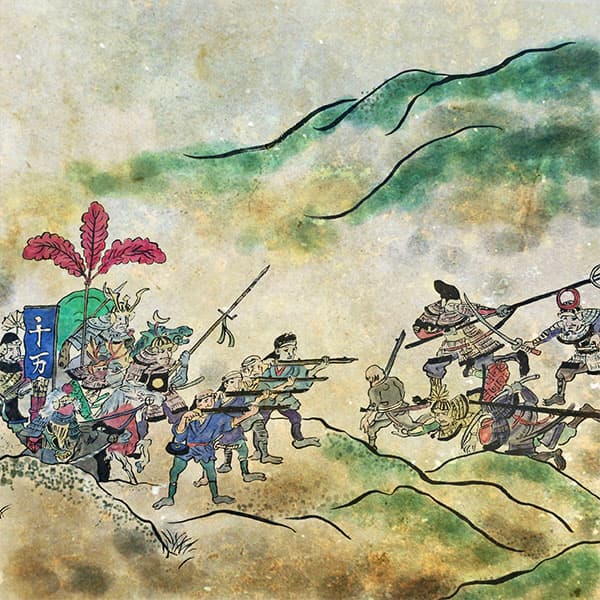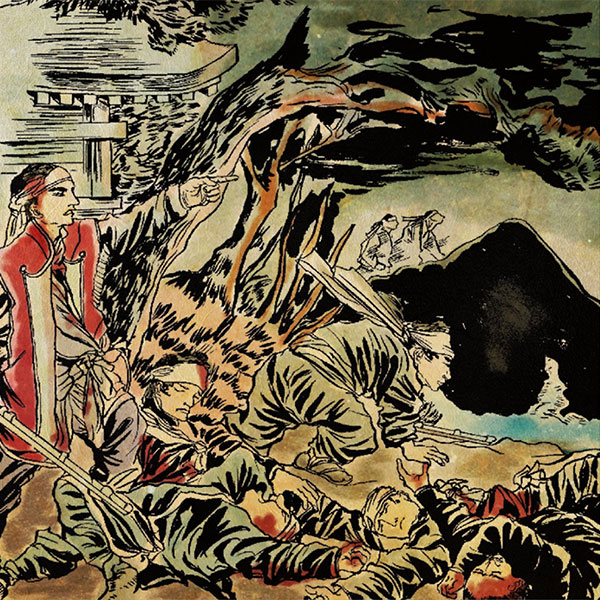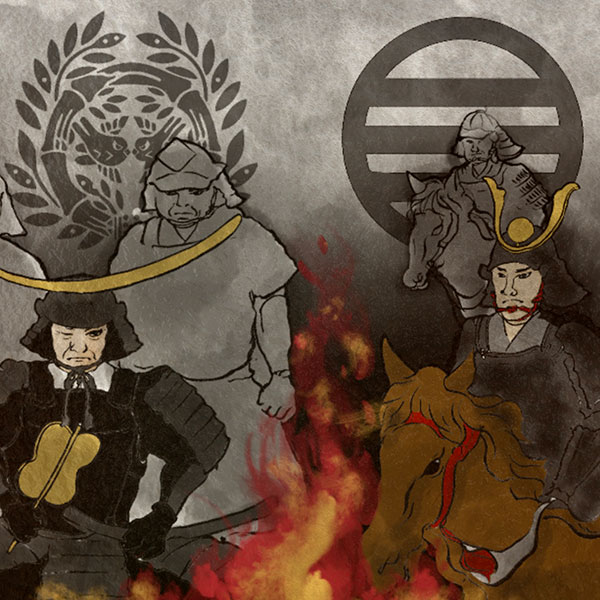- Aizu domainRuled by the Uesugi and Aizu Matsudaira families.
- The Aizu domain was a strategic point in the Tohoku region that was captured by Date Masamune from the Aizu Ashina clan, and then commandeered by Toyotomi Hideyoshi. From the beginning of the Edo period, the Aizu Matsudaira family, whose origin was Masayuki Hoshina, the fourth son of Hidetada Tokugawa, served as the lord of the Aizu domain until the end of the Edo period. child

Tsuruga CastleAizuwakamatsu City, Fukushima Prefecture
| Other name | Aizuwakamatsu Castle, Kurokawa Castle |
|---|---|
| castle construction | 1384 |
| address | 1-1 Otemachi, Aizuwakamatsu City, Fukushima Prefecture |
| telephone number | 0242-27-4005 |
| Opening hours | 8:30 a.m. to 5:00 p.m. (Last entry is 4:30 p.m.) |
| closing day | No holidays |
| Admission fee | Adults 410 yen, children 150 yen |
Tsuruga Castle is one of Japan's top 100 castles. An impregnable famous castle.
- Access to Tsuruga Castle
- From JR Aizuwakamatsu Station, take one of the four routes within the city, such as those bound for Takada or Nagaino via Ashinomaki or Nengocho, and get off at Tsurugajo Nishiguchi.
HISTORYTsurugasaki Castle, a red-tiled castle that was the site of a fierce battle during the Boshin War
Tsurugasaki Castle is a Hirayama castle built in Aizuwakamatsu City, Fukushima Prefecture. It is also known as Wakamatsu Castle because it is registered as a national historic site under the name ``Wakamatsu Castle Ruins''. At the end of the Edo period, it also became the site of a fierce battle during the Boshin War. Here, we will look into the history of Tsurugasaki Castle.
- Medieval Tsurugasaki Castle
- It is said that Tsurugasaki Castle began in 1384 when a man named Naomori Ashina, the seventh generation of the Aizu Ashina clan, built a mansion called Higashi Kurokawakan. I am. The details of how this mansion became a castle are unknown, but in the 15th century it became Kurokawa Castle, a castle town was born, and it became the residence of the Aizu Ashina clan. Later, during the Sengoku period, the Ashina clan expanded its power around Kurokawa and became a powerful daimyo in Tohoku, on a par with the Date clan, famous for Date Masamune.
- Toyotomi Hideyoshi took Aizu from Date Masamune
- In 1589, Date Masamune, who was in a territorial dispute with the Aizu Ashina clan, ignored Toyotomi Hideyoshi's restraints and attacked Ashina Yoshihiro, destroying the Aizu Ashina clan and taking possession of Kurokawa Castle. However, in the following year, 1590, Date Masamune expressed his intention to submit to Toyotomi Hideyoshi, and Aizu came under the direct control of Toyotomi Hideyoshi, and his loyal vassal Ujisato Gamo was appointed as the castle owner. There is a theory that this was done to keep Date Masamune in check.
Ujisato Gamo renovated Kurokawa Castle into a modern castle and renamed it Wakamatsu Castle. There is a theory that this name originates from Wakamatsu Shrine, which was located near the approach to Umamioka Watamukai Shrine, which was the guardian deity of the Gamo clan, and another theory that it originates from Matsusaka, which was their territory.
In 1593, a seven-story watchtower-shaped castle tower was completed, and the castle's name was changed from Wakamatsu Castle to Tsurugasaki Castle. However, in 1598, when Ujisato Gamo's son, Hideyuki Gamo, took over as head of the family, a commotion broke out in the family after he underreported the amount of stone. After Toyotomi Hideyoshi confiscated the Aizu territory, he made conditions such as accepting Tokugawa Ieyasu's daughter Furihime as his legal wife, and demolishing all castles other than Aizuwakamatsu Castle and seven branch castles. With Hideyuki Gamo's approval, Aizu territory was once again given to the Gamo clan. However, Hideyuki Gamo was unable to control his senior vassals and had his koku reduced from 920,000 koku to 180,000 koku, and was transferred to Utsunomiya, Shimotsuke Province. After that, Tsurugasaki Castle was given to Kagekatsu Uesugi. - Tsurugasaki Castle in the Edo period
- When the Battle of Sekigahara occurred in 1600, Uesugi Kagekatsu sided with the Western army. Therefore, after the battle was over, Tokugawa Ieyasu transferred Uesugi Kagekatsu to Utsunomiya, Shimotsuke Province, and had Hideyuki Gamo rule over Aizu again in his place. However, in 1627, Hideyuki Gamo's eldest son, Tadasato Gamo, died without being blessed with an heir, so Yoshiaki Kato entered the castle and, together with his son Akinari Kato, built extensions such as Nishidemaru and Kitademaru. I did. At this time, the castle tower, which had collapsed due to the Aizu earthquake in 1611, was rebuilt as a layered tower tower, which is currently being restored. In 1643, Kato Akinari was transferred to the castle, and Masayuki Hoshina entered the castle in his place. The Hoshina family later changed their name to the Aizu Matsudaira family, and Tsurugasaki Castle remained the residence of the Aizu Matsudaira family until the Meiji era.
- Tsurugasaki Castle and the Boshin War
- In 1868, the Aizu War, one of the phases of the Boshin War, broke out. This was a battle that occurred over the treatment of the Aizu clan between the Meiji government forces and the Ouuetsu clan alliance, which directed the former shogunate. The entire Aizu domain became a battlefield, but Tsurugasaki Castle became the stage for the final siege battle. The Aizu domain withstood the attack by Meiji government forces for a month, but when the Yonezawa domain and others surrendered, the era name changed from Keio to Meiji, and it surrendered on November 6th. After this, Tsurugasaki Castle was handed over to the Meiji government, placed under the jurisdiction of the Ministry of Military Affairs, and managed by the Sendai Chindai. The effects of the Aizu War were large and many buildings were damaged, but these buildings were not rebuilt and were gradually demolished. In addition, a photo of the damaged Tsurugasaki Castle tower, said to have been taken in 1873, still exists.
- Tsurugasaki Castle after the Meiji era
- In 1874, the Meiji government issued the Nationwide Regulation on the Preservation, Abolition, and Disposal of Castles and the Selection of Military Encampments (commonly known as the Castle Abolition Order), and Tsurugasaki Castle became the property of the Army. The following year, all the buildings, including the castle tower, were demolished. One of the turrets, the Gosankai, still exists, having been relocated to a temple called Amida-ji Temple in Nanokamachi, Aizuwakamatsu City in 1899. Additionally, the Karaha style front entrance was also relocated from Honmaru Daishoin and is now the entrance to the third floor.
In 1890, when it was decided that part of the land in the castle ruins would be sold to the private sector, Keiji Endo, a former Aizu feudal samurai and Ministry of Finance official, later served as the second and fourth president of the 77 Bank. In order to preserve the entire castle ruins, a man gave up his personal wealth to purchase the land and donated it to the former feudal lord, the Matsudaira family.
Later, in 1908, when an army regimental training ground was built, part of Sannomaru, its moat, and earthworks, approximately 6ha, were removed, but the remaining 23ha of the castle ruins remained. It was designated as a national historic site by the Ministry of Education in 1934. - Current Tsurugasaki Castle
- In 1965, the exterior of Tsurugasaki Castle's castle tower was restored using reinforced concrete construction. Inside is the Wakamatsu Castle Castle Folk Museum. In 1990, the tea room "Rinkaku", which is said to have been built by Shoan, the eldest son of Sen no Rikyu, was moved and restored to its original location in the Honmaru, and in 2001, it was rebuilt as a rice turret within the Honmaru. The Minami-Hashiri Nagaya building will be restored and made of wood. In 2010, the roof of the castle tower was replaced with red tiles from the time of the Boshin War. Currently, the Wakamatsu Castle ruins include the restored castle tower, the Imperial Medicine Garden, which was a large strolling garden during the feudal period, the Chōyōkaku, a building associated with Princess Setsuko of Chichibu, the grandson of the feudal lord Katamori Matsudaira, and the tea room Rinkaku. The garden, tea room, and restored castle tower are open to the public as a museum.
Read about incidents related to Tsuruga Castle
Read biographies related to Tsuruga Castle
- Kagekatsu UesugiA righteous Hokuriku man
- During the Sengoku period, Uesugi Kenshin, the ``Dragon of Echigo,'' opposed Takeda Shingen, who was feared by those around him as the ``Tiger of Kai.'' After Kenshin passed away, Kagekatsu Uesugi led the Uesugi family. Kagekatsu teamed up with Ishida Mitsunari to fight against Tokugawa Ieyasu at the Battle of Sekigahara.

History of the Aizu domain, whose domain office is Tsuruga Castle
| Domain office | Tsuruga Castle |
|---|---|
| old area | Mutsu Gaitsu District |
| stone height | 280,000 koku |
| Fudai/Tozama | Parent clan |
| main lord | Matsudaira family |
| Estimated population | 225,774 people (Ansei 5) |
Masayuki Hoshina, the founder of the domain, supported the fourth shogun, Ietsuna Tokugawa, as a key figure in the shogunate, and also played a major role in laying the foundations of the Aizu domain.
HighlightsSightseeing Spots
Tsuruga Castle column
Introduction column by castle enthusiasts





































